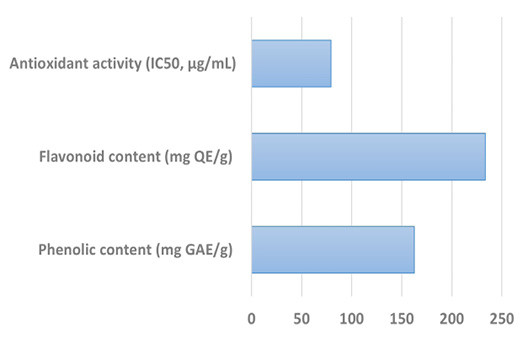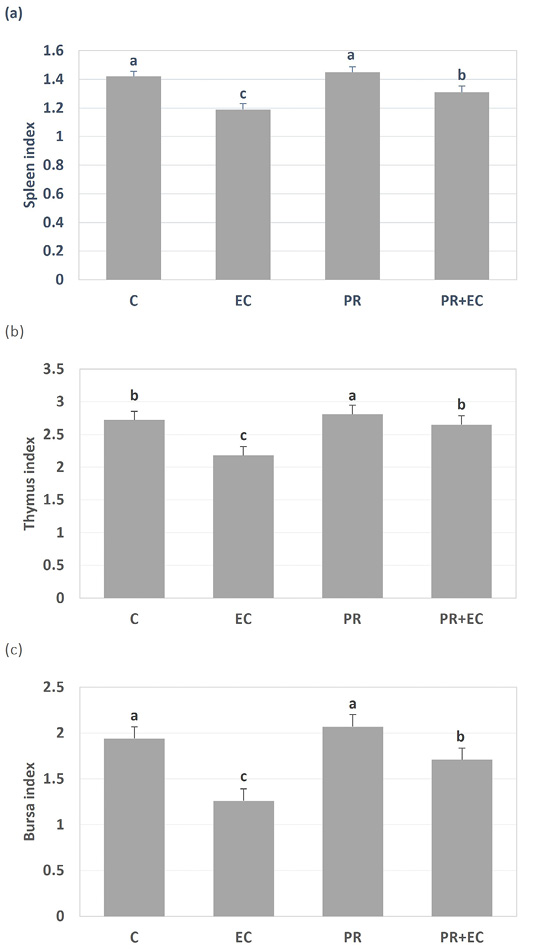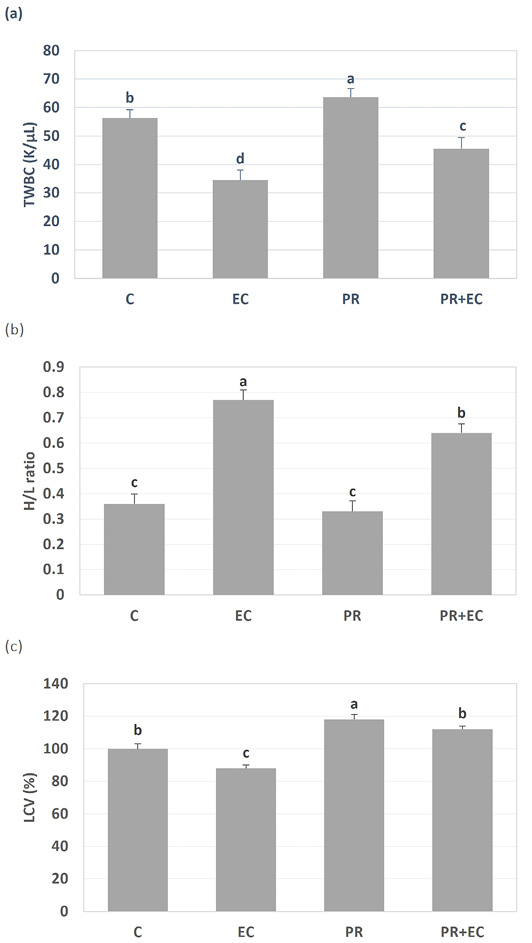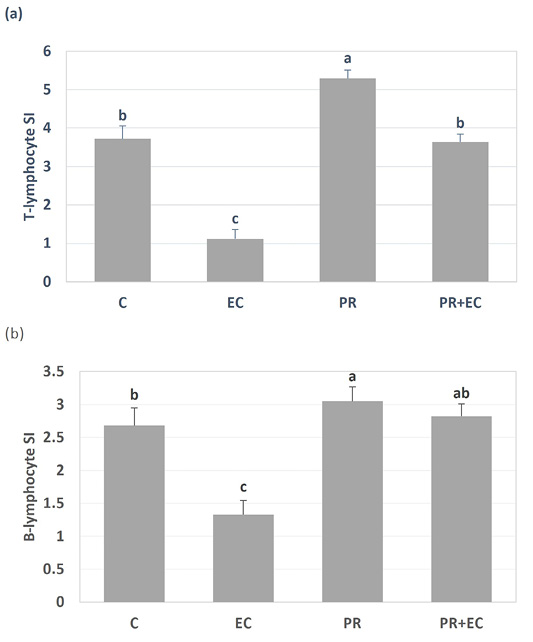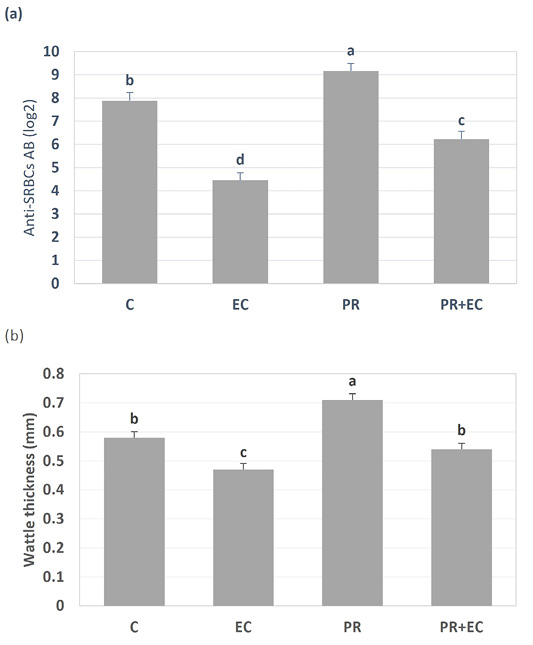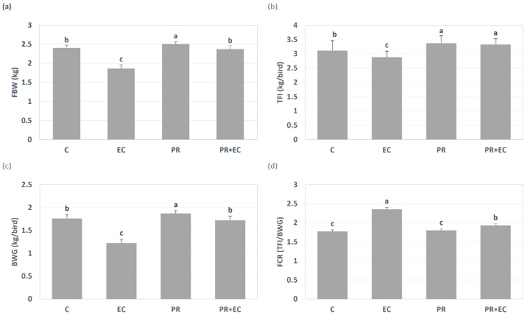Propolis Inclusion into Broiler Diets Improves the Immunomodulation and Productive Performance After Challenge with Escherichia coli Infection
Propolis Inclusion into Broiler Diets Improves the Immunomodulation and Productive Performance After Challenge with Escherichia coli Infection
Abdulaziz A. Alaqil
Polyphenolic and flavonoid contents of propolis were calculated as gallic acid equivalent (GAE) and quercetin equivalent (QE), respectively. Total antioxidant activity was determined in terms of IC50 (the sample concentration that achieves 50% inhibition of the 2,2-diphenyl-1-picrylhydrazyl (DPPH) free radicals).
Effect of dietary propolis (PR) supplementation on (a) spleen index, (b) thymus index, and (c) bursa index of broiler chickens challenged with Escherichia coli (EC) infection. Bars express the mean (n = 20) with standard error (SE). Means with dissimilar letters significantly differ at p < 0.05. Treatment groups: C, control group without PR supplementation or EC challenge; EC, group without PR supplementation but challenged with EC; PR, group supplemented with PR but not challenged with EC; PR+EC, group supplemented with PR and challenged with EC.
Effect of dietary propolis (PR) supplementation on (a) total white blood cells (TWBC) count, (b) heterophil to lymphocyte (H/L) ratio, and (c) leukocyte cell viability (LCV) of broiler chickens challenged with Escherichia coli (EC) infection. Bars express the mean (n = 20) with standard error (SE). Means with dissimilar letters significantly differ at p < 0.05. Treatment groups: C, control group without PR supplementation or EC challenge; EC, group without PR supplementation but challenged with EC; PR, group supplemented with PR but not challenged with EC; PR+EC, group supplemented with PR and challenged with EC.
Effect of dietary propolis (PR) supplementation on (a) T-lymphocyte proliferation, and (b) B-lymphocyte proliferation of broiler chickens challenged with Escherichia coli (EC) infection. Bars express the mean of stimulation indexes (SI) for T- or B-lymphocytes (n = 20) with standard error (SE). Means with dissimilar letters significantly differ at p < 0.05. Treatment groups: C, control group without PR supplementation or EC challenge; EC, group without PR supplementation but challenged with EC; PR, group supplemented with PR but not challenged with EC; PR+EC, group supplemented with PR and challenged with EC.
Effect of dietary propolis (PR) supplementation on (a) anti-sheep red blood cells antibody (anti-SRBCs-AB) titer, and (b) wattle thickness of broiler chickens Bars express the mean (n = 20) with standard error (SE). Means with dissimilar letters significantly differ at p < 0.05. Treatment groups: C, control group without PR supplementation or EC challenge; EC, group without PR supplementation but challenged with EC; PR, group supplemented with PR but not challenged with EC; PR+EC, group supplemented with PR and challenged with EC.
Effect of dietary propolis (PR) supplementation on the productive performance of broiler chickens challenged with Escherichia coli (EC) infection. (a) final body weight (FBW) at 42 d of age, (b) total feed intake (TFI), (c) body weight gain (BWG), and (d) feed conversion ratio (FCR). Bars express the mean (n=10) with standard error (SE). Means with dissimilar letters significantly differ at p < 0.05. Treatment groups: C, control group without PR supplementation or EC challenge; EC, group without PR supplementation but challenged with EC; PR, group supplemented with PR but not challenged with EC; PR+EC, group supplemented with PR and challenged with EC.




